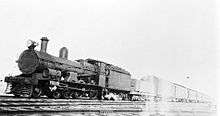Commonwealth Railways G class
|
Preserved G1 at the National Railway Museum in April 2014 | |||||||||||||||||
| |||||||||||||||||
| |||||||||||||||||
| |||||||||||||||||
| |||||||||||||||||
The Commonwealth Railways G class was a class of 4-6-0 tender locomotives of the Commonwealth Railways, Australia. The class operated on the 1,435 mm (4 ft 8 1⁄2 in) Trans-Australian Railway.
History

In order to operate passenger trains on the then under construction Trans-Australian Railway, Commonwealth Railways ordered sixteen locomotives of the same design as the New South Wales Government Railways' P class (later the C32 class), but with higher capacity tenders.[1][2]
Four were built by Clyde Engineering, Sydney and twelve by the Baldwin Locomotive Works, Philadelphia with all delivered between March and August 1914. A further ten were delivered by the Toowoomba Foundry between June 1916 and August 1917.[1][2]
Initially they were used on construction trains, until the line opened in October 1917, when they commenced hauling passenger trains including the Trans Australian. Although just as successful as their New South Wales counterparts, the high mineral content of the water caused problems. Two were withdrawn in 1925 followed by a third in 1930.[1]
In the 1930s, seven were fitted with superheated boliers to replace the saturated examples. These were reclassifed as the Ga class. Following their displacement by the larger C class locomotives in 1938, they were gradually withdrawn.[1]

By the time dieselisation commenced in 1951, only eleven remained in service. Most were withdrawn in 1952 as the GM class diesels entered service. The last remained in service as a shunter at Port Pirie until withdrawn in September 1958.[1]
One has been preserved and today is on display at the National Railway Museum, Port Adelaide. It is believed that although numbered G1, it was actually originally G2.[2][3]
References
Notes
Bibliography
- Fluck, Ronald E; Marshall, Barry; Wilson, John (1996). Locomotives and Railcars of the Commonwealth Railways. Welland, SA: Gresley Publishing. ISBN 1876216018.
External links
![]() Media related to Commonwealth Railways G class locomotives at Wikimedia Commons
Media related to Commonwealth Railways G class locomotives at Wikimedia Commons